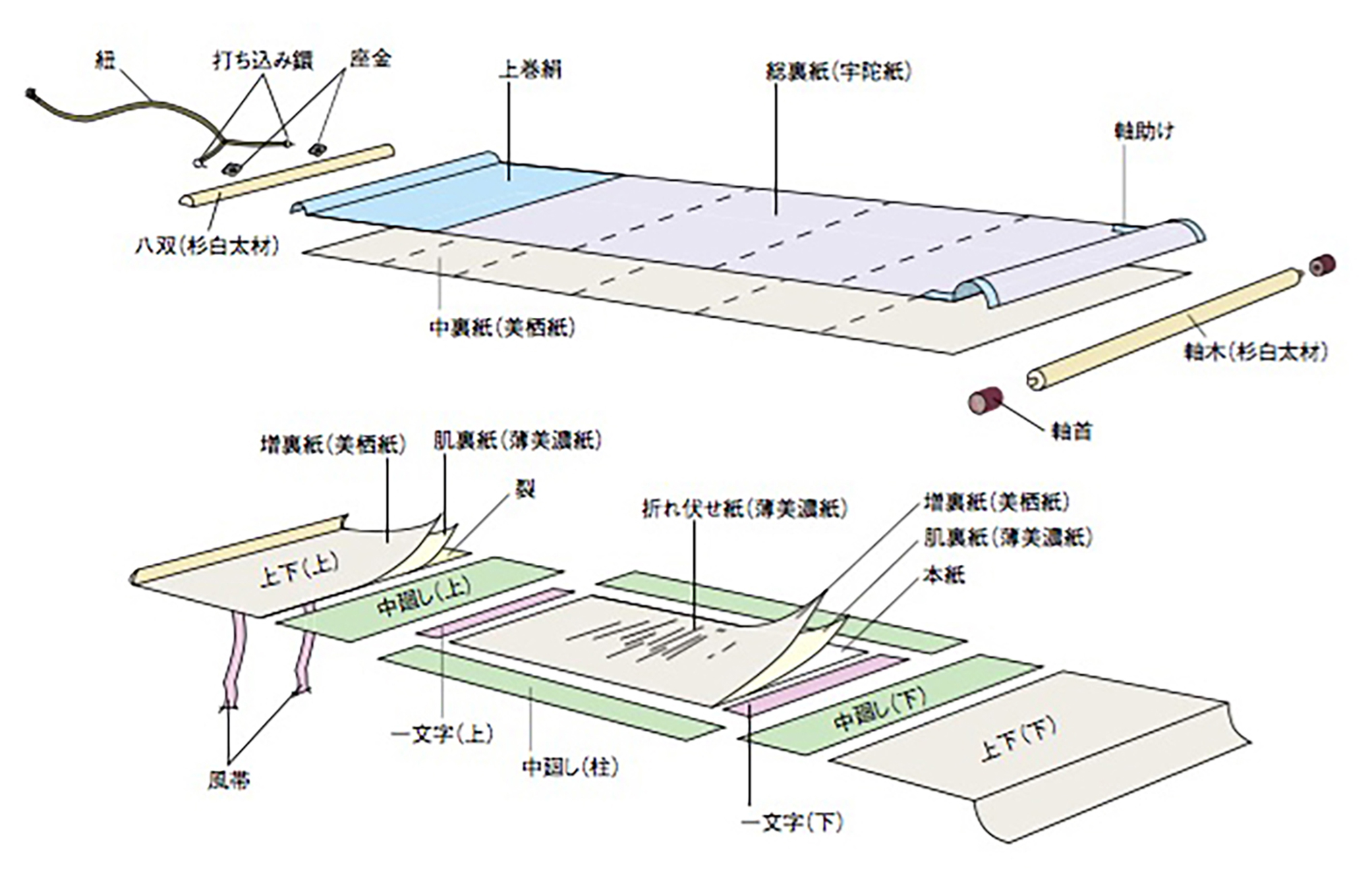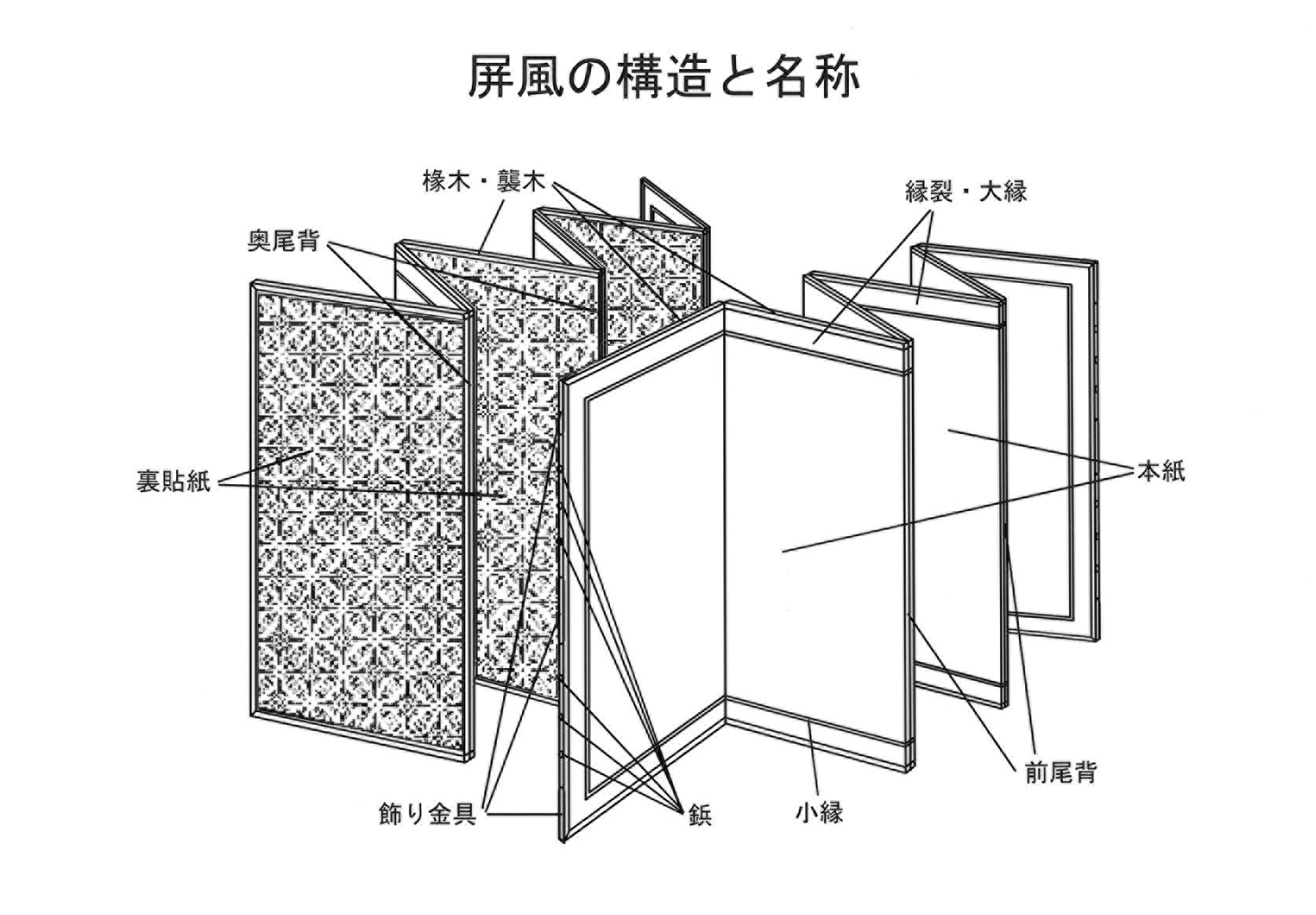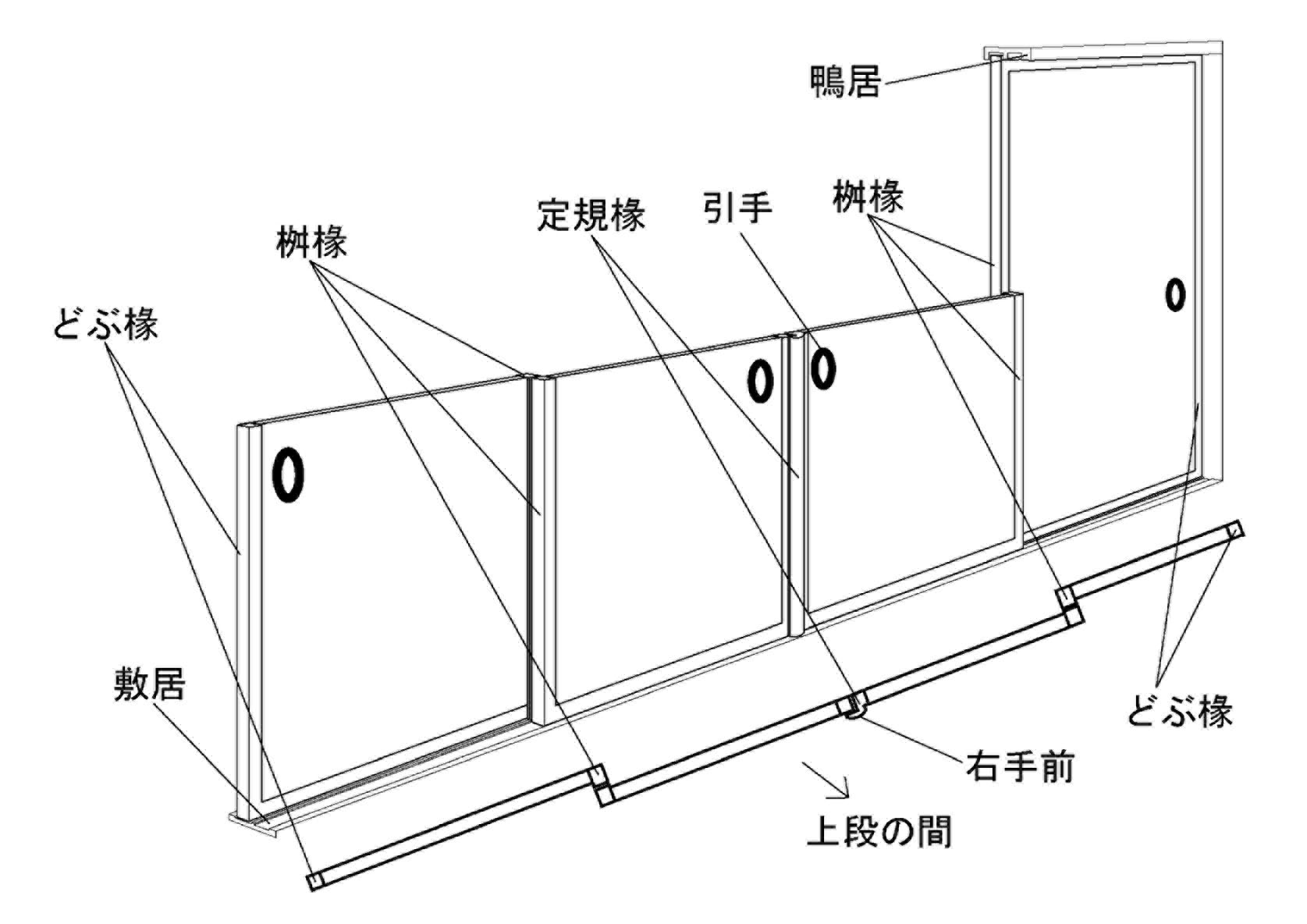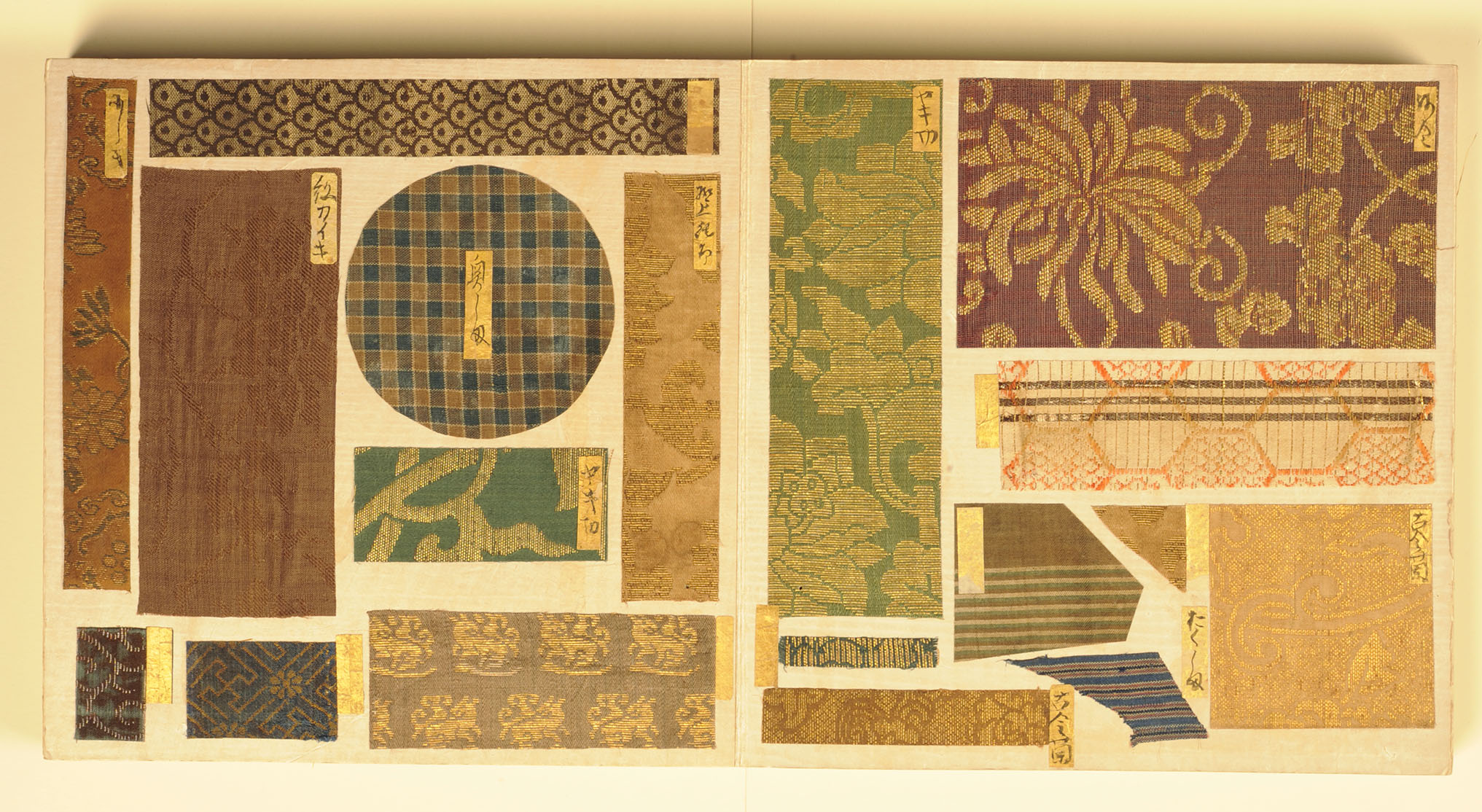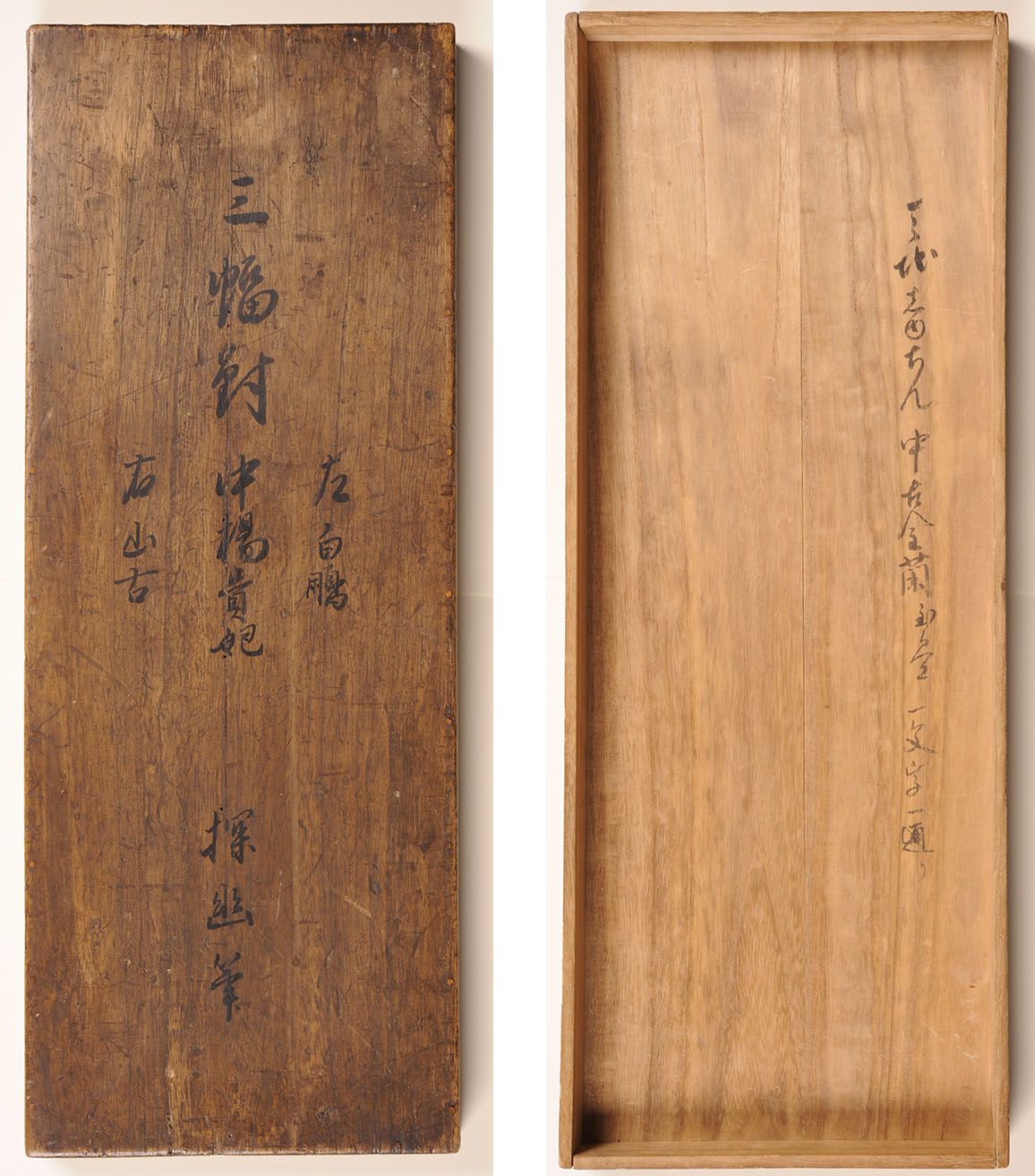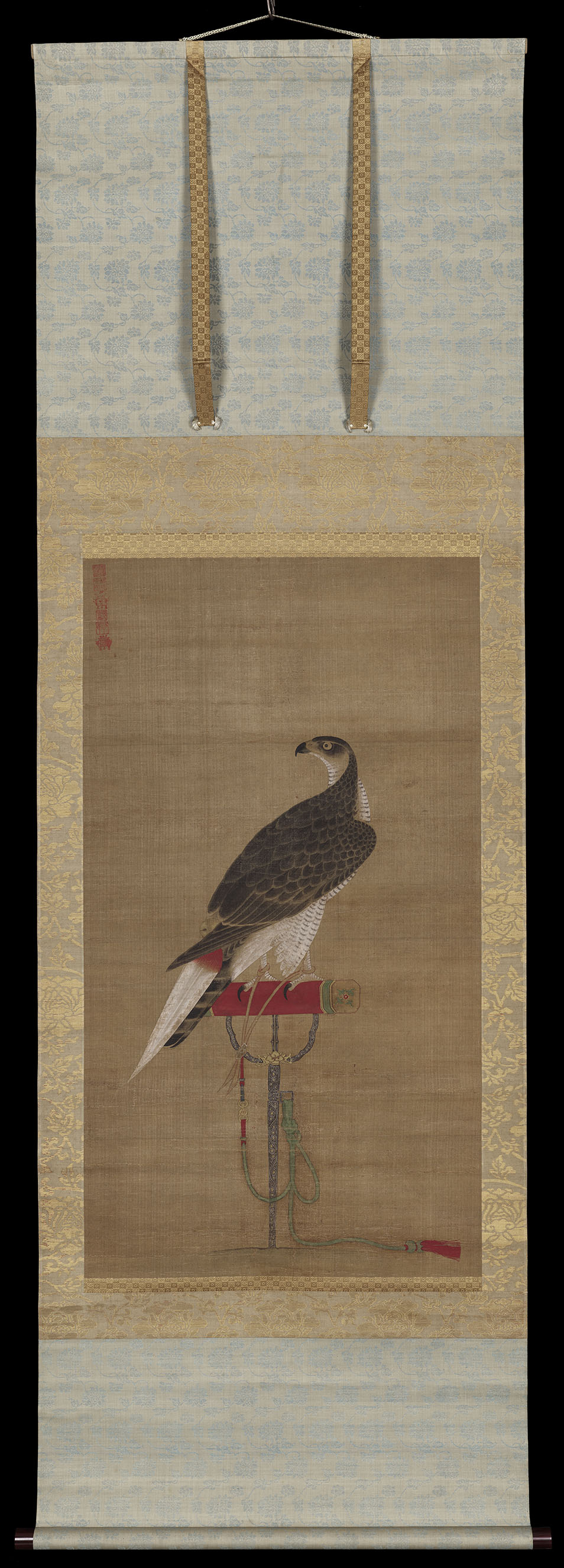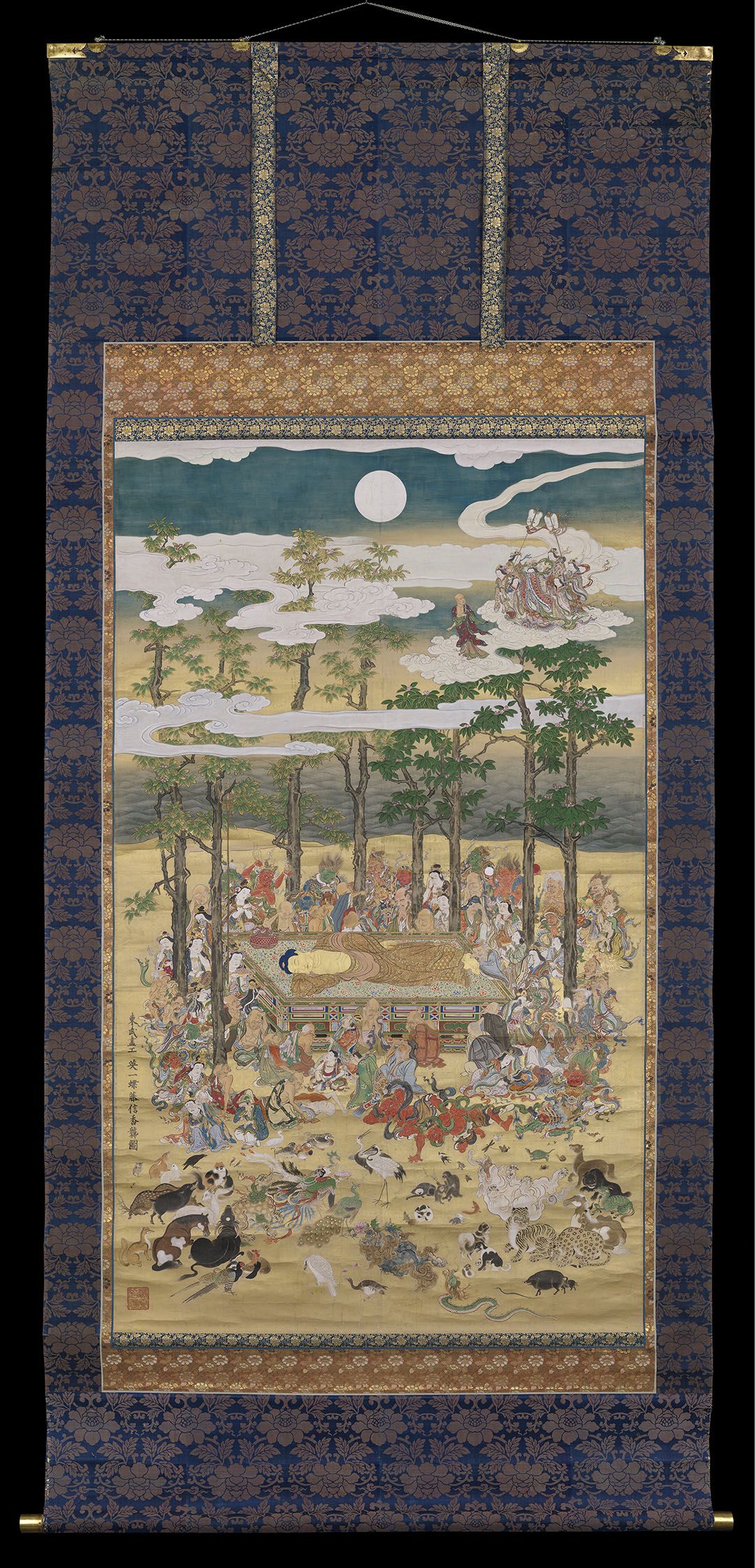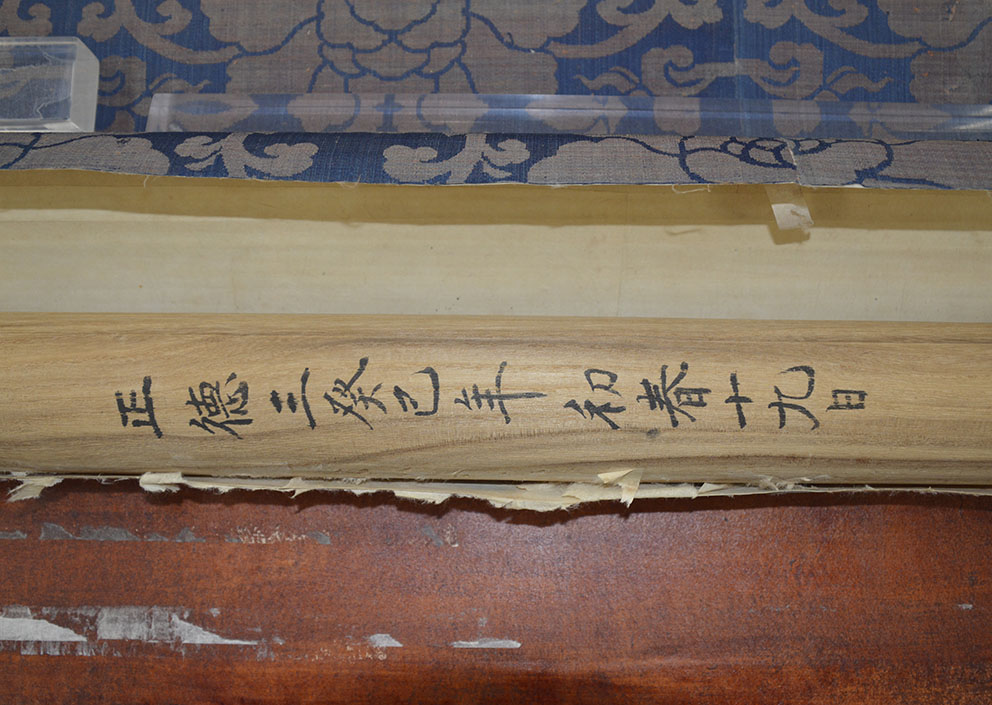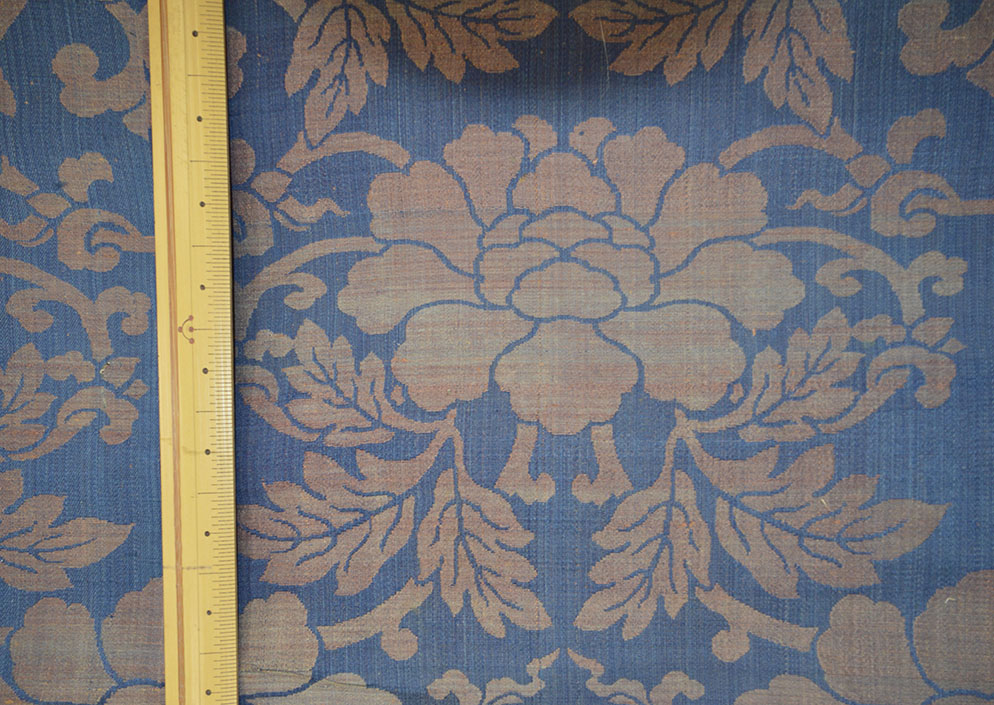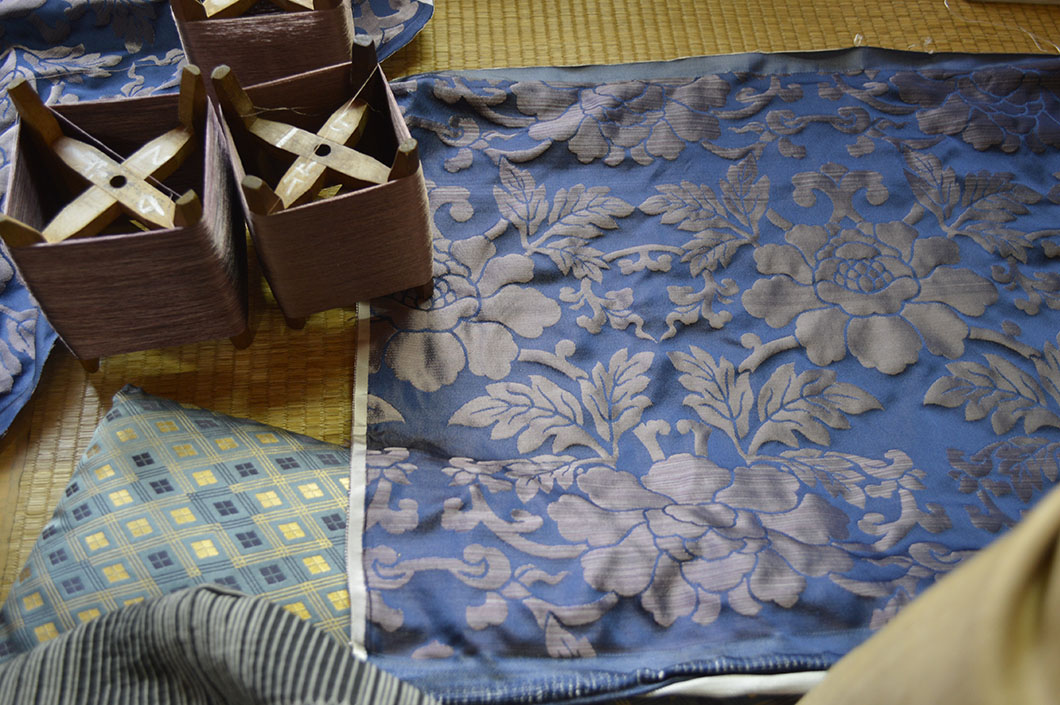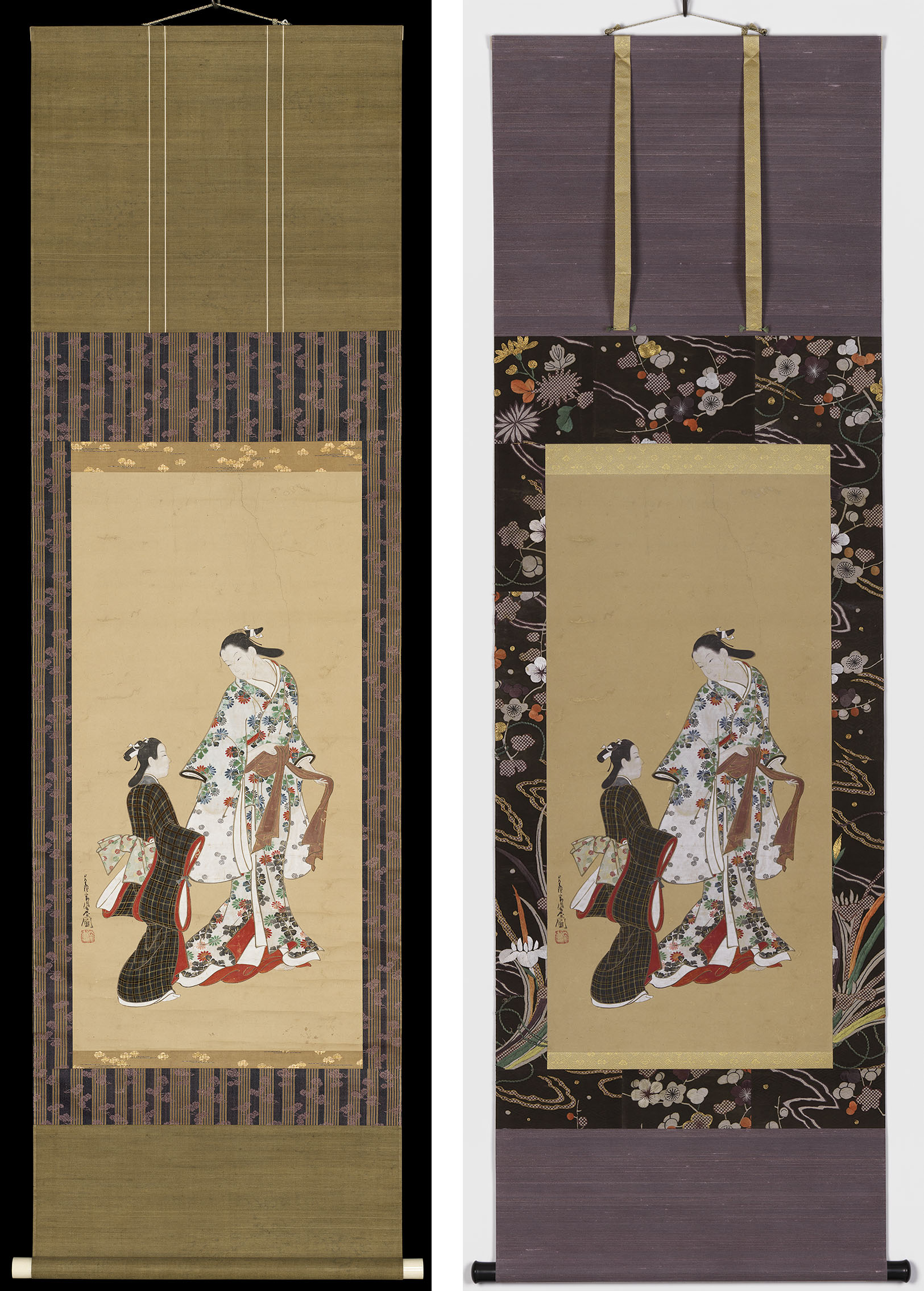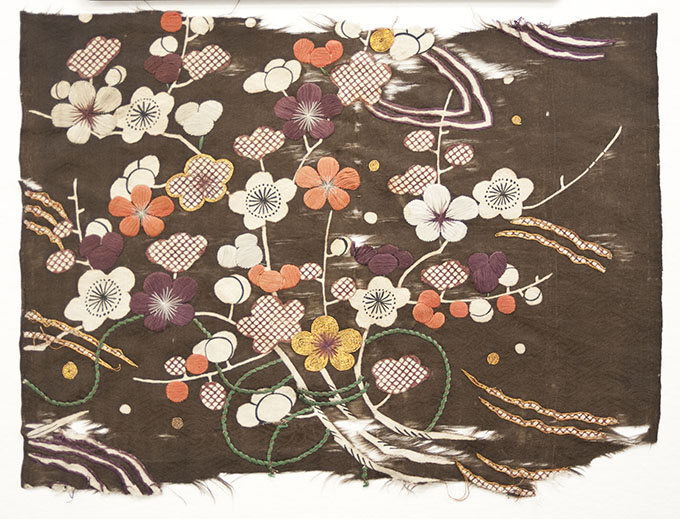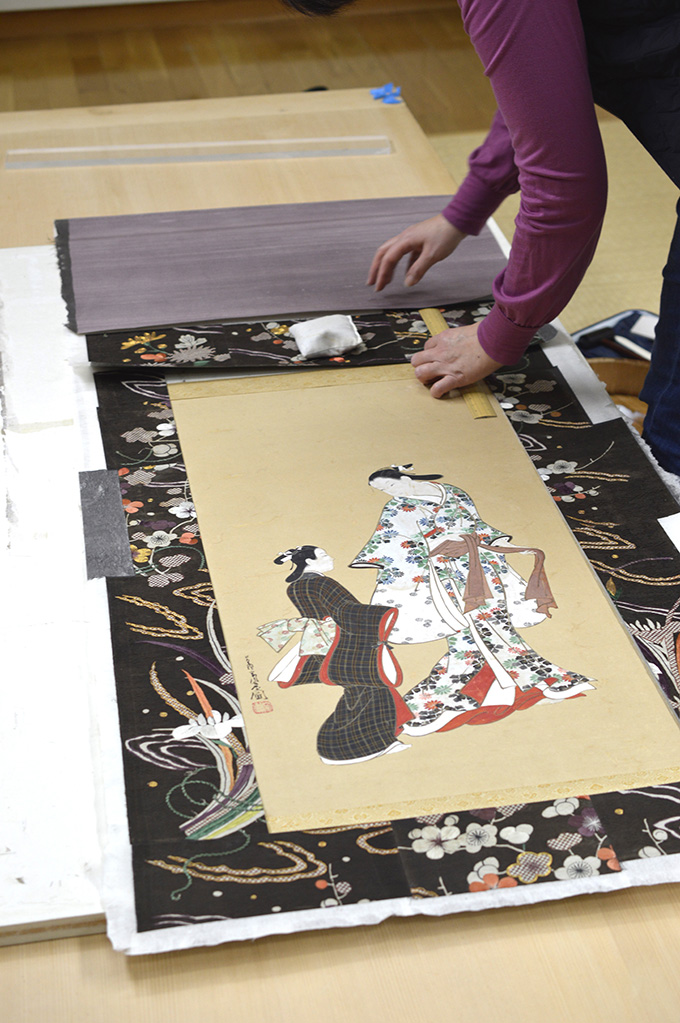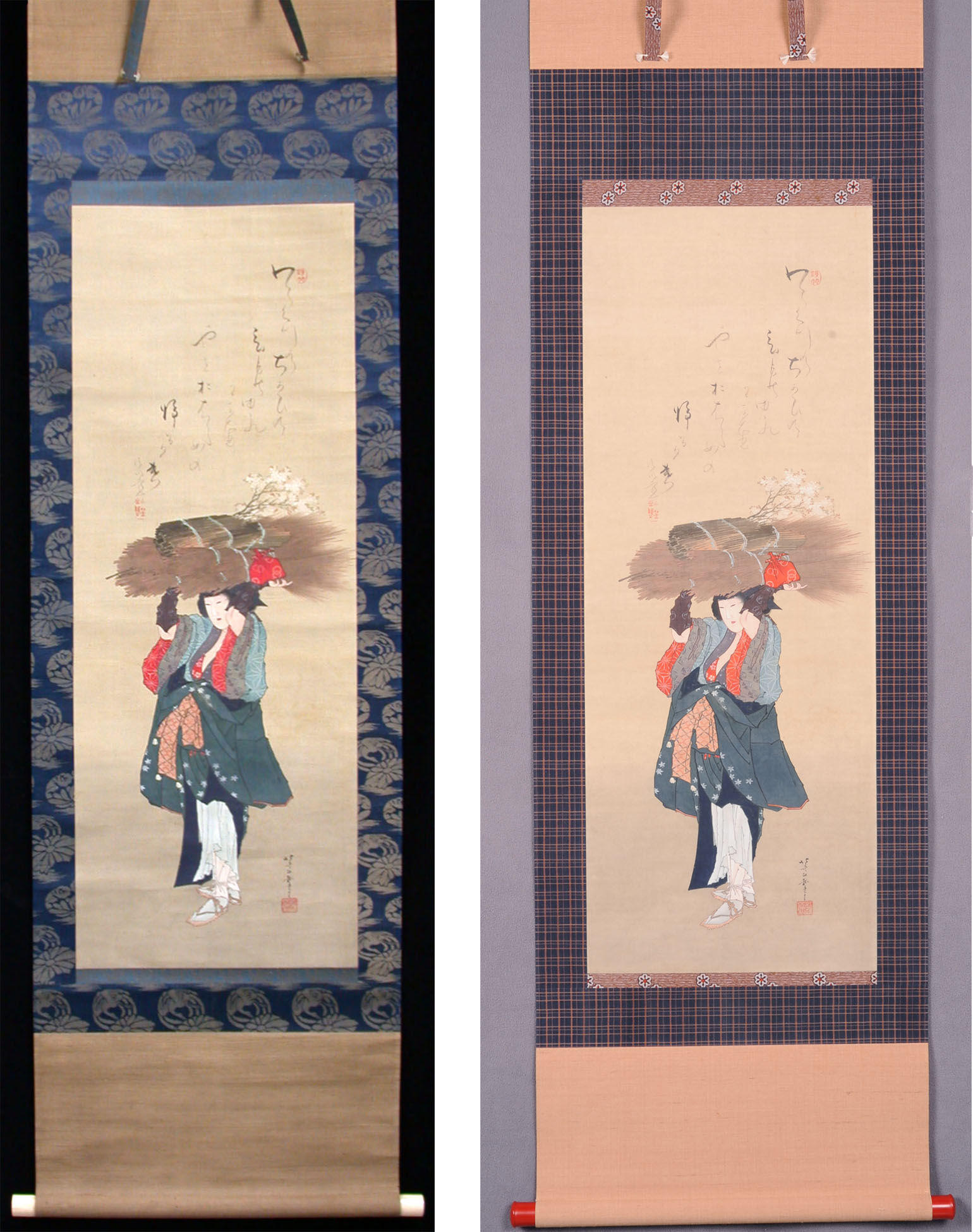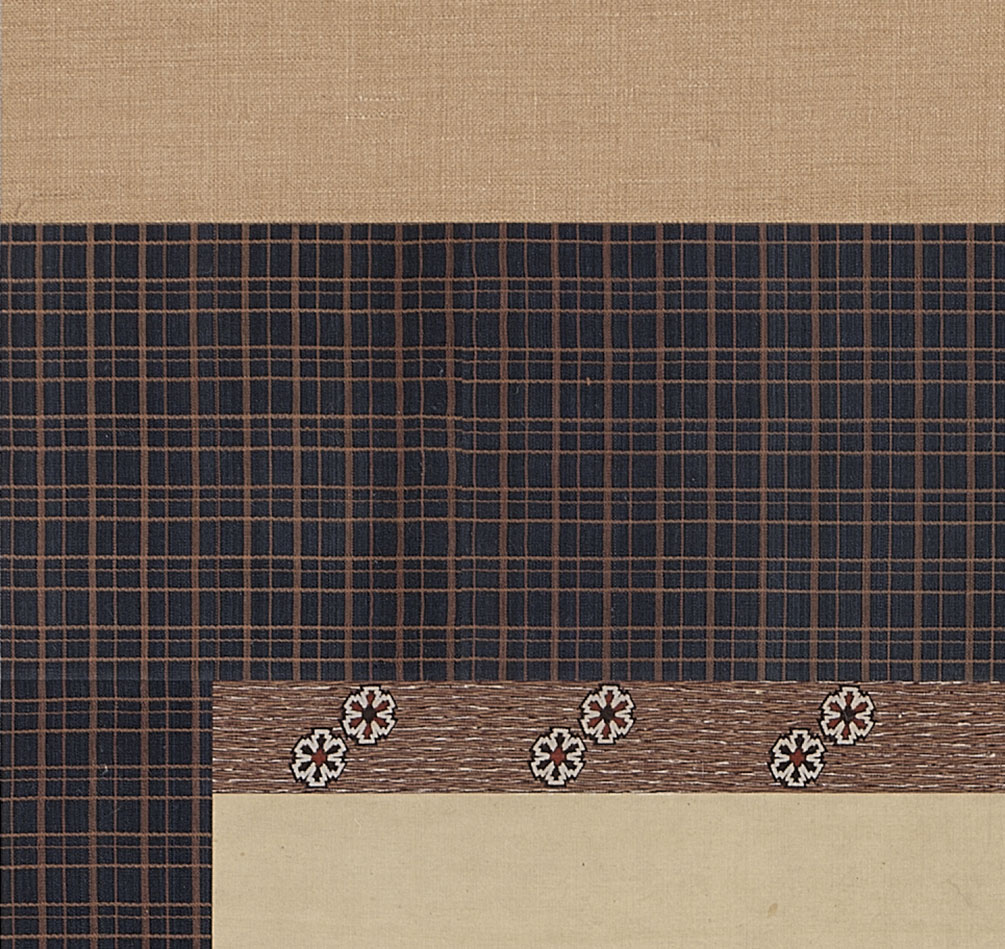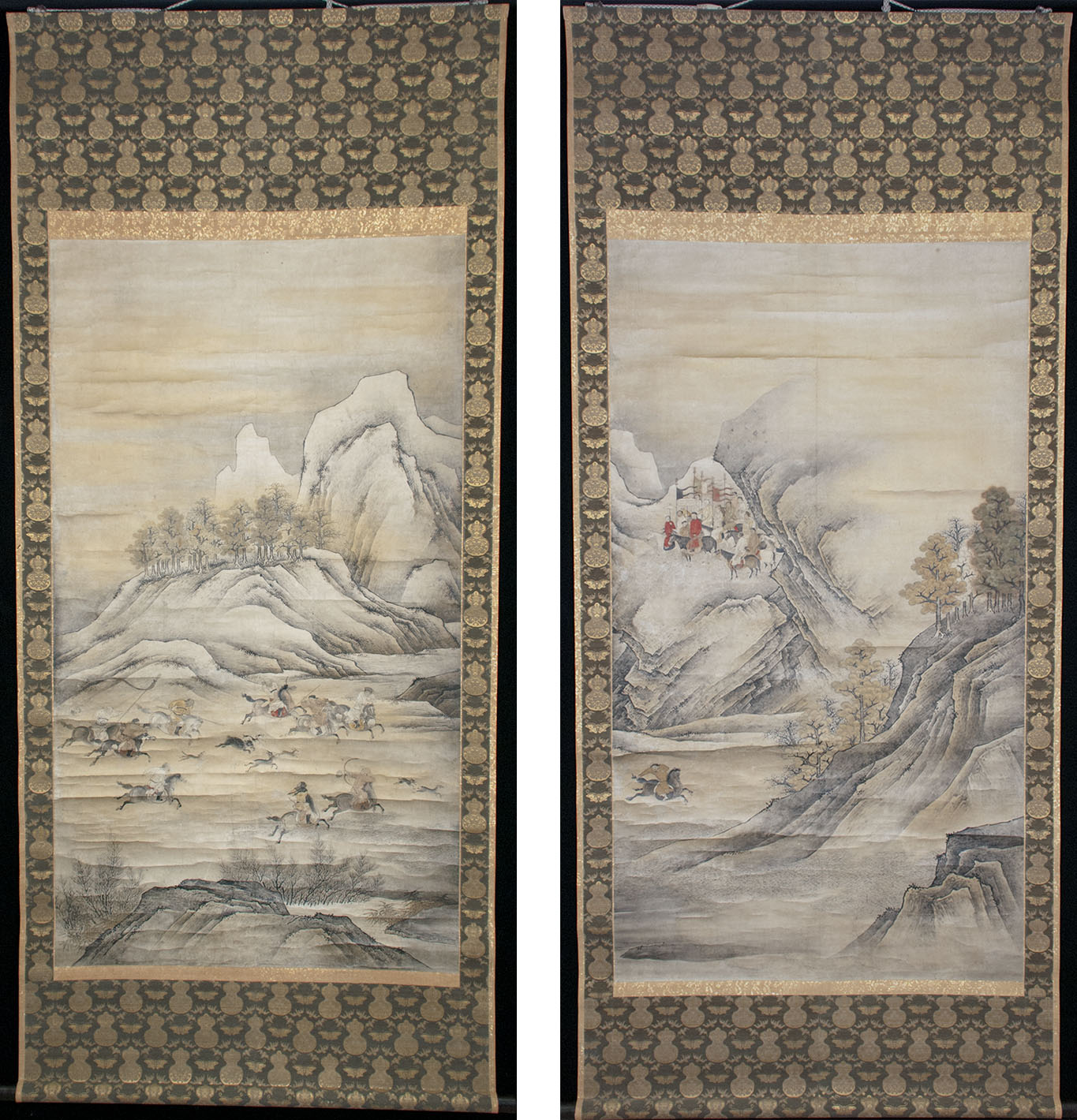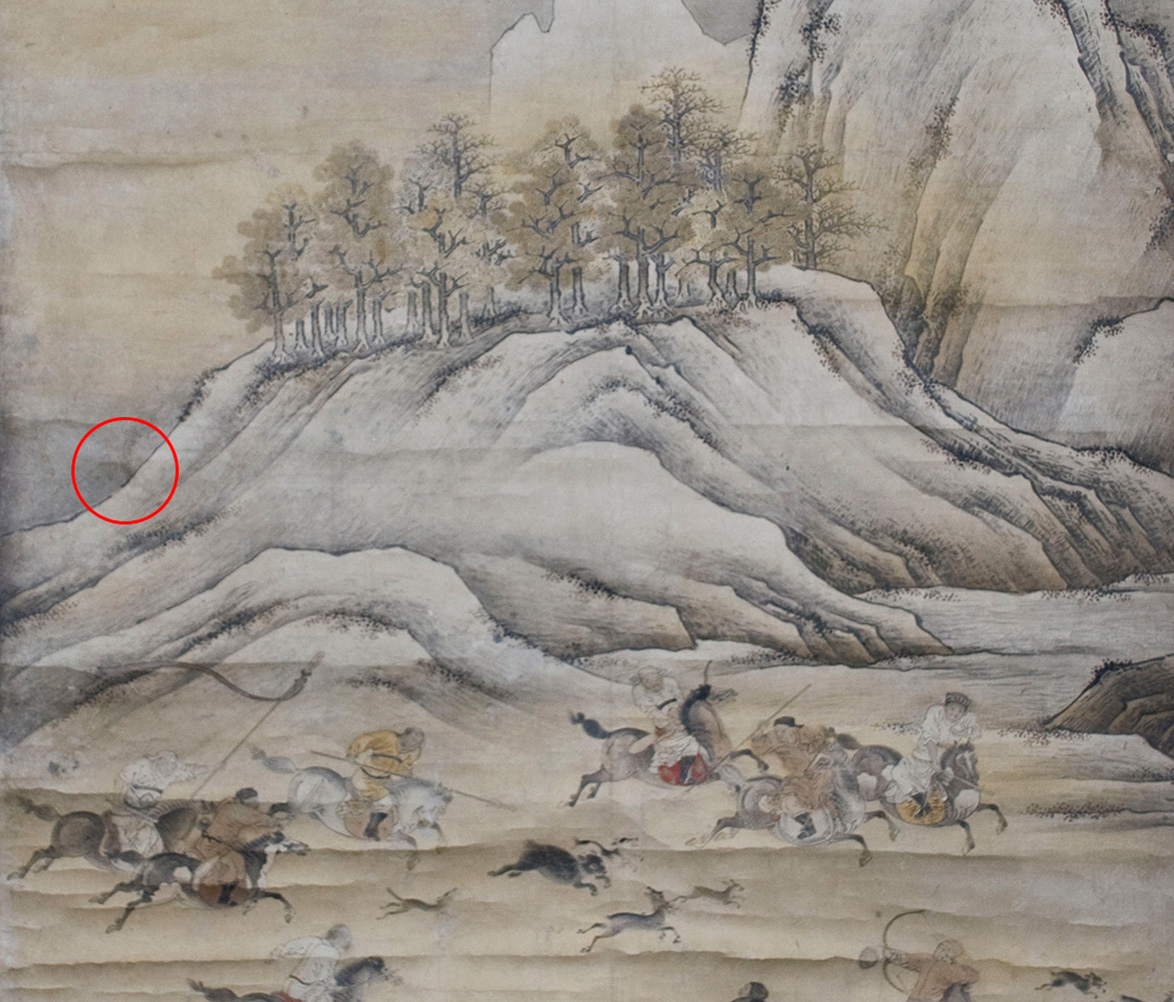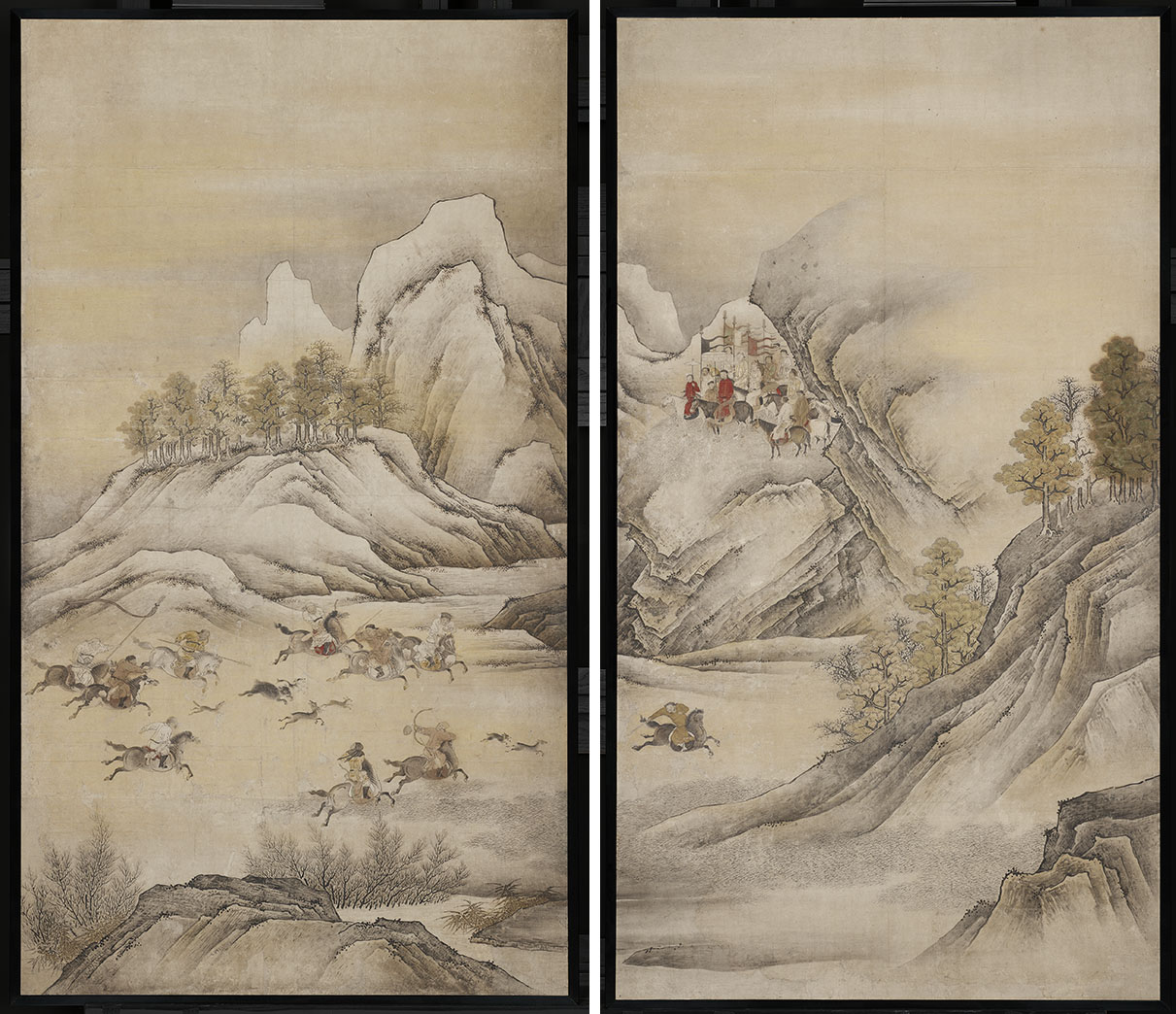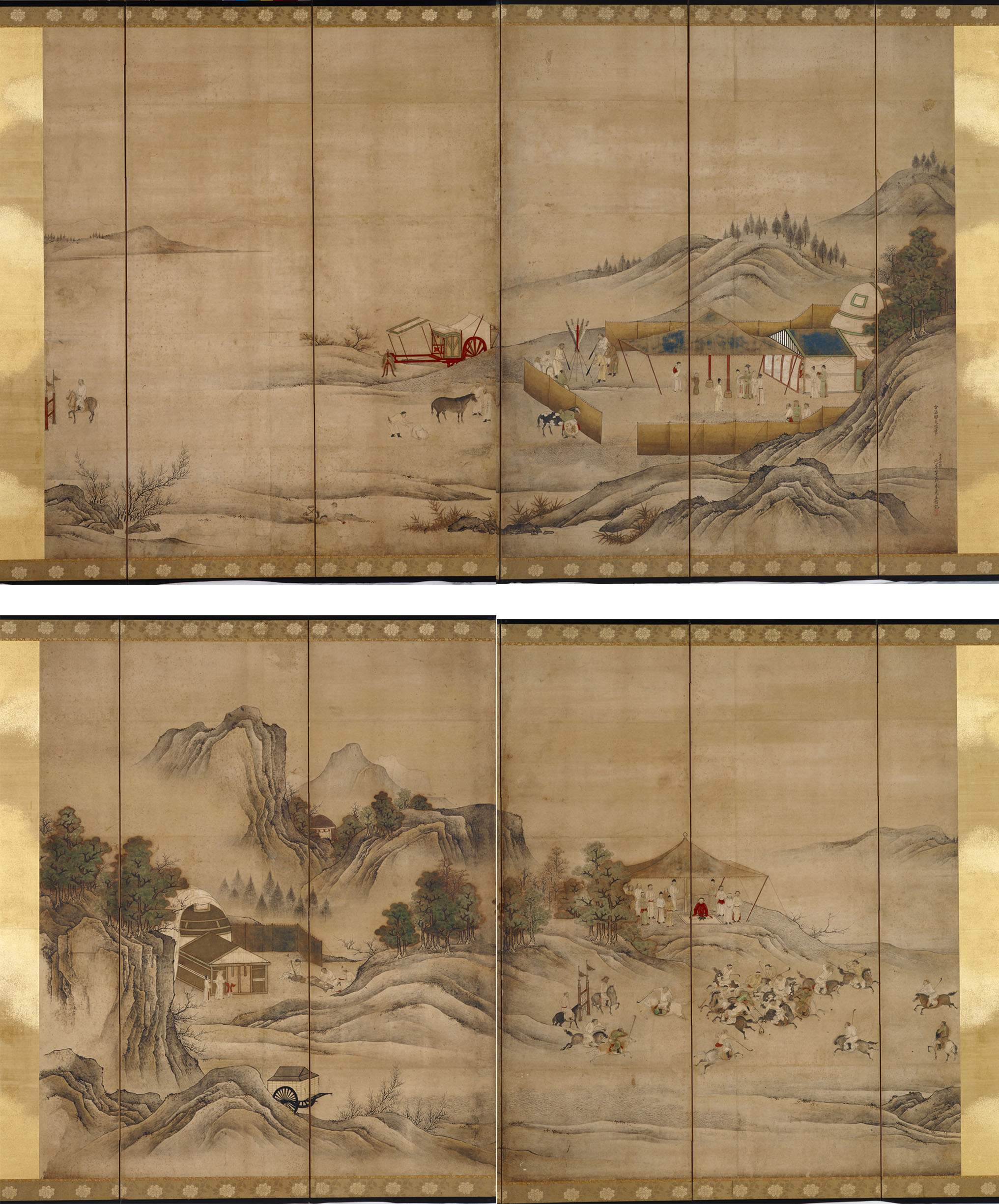Introduction
Most Japanese paintings and calligraphies have survived over the centuries, in spite of their inherent fragility, as a direct result of periodic conservation treatments. The current state of a Japanese painting is a moment in time along a continuum of decisions and circumstances that greatly influence the appearance, function, and appreciation of the work of art. Display formats such as hanging scrolls and folding screens are complex arrangements of specialized, high-value materials such as gold brocades, decorative metal fittings, and lacquered end knobs. While the mount’s primary function is to physically support the artwork, it imparts an important aesthetic component as well. Because the format of an artwork is contingent on the intended display setting, the format may undergo significant changes throughout the lifetime of a work. A single handscroll may be divided into separate hanging scrolls, for example, and sold as individual works of art. Therefore, the format and mounting play an important role in the function and identity of the artwork, and often contain important information on its history. Due to the physical requirements of display, most conservation treatments of Japanese paintings prioritize renewal and replacement, rather than reuse and recycling. Deteriorated lining papers and mounting brocades, even those of high value, must be replaced if they can no longer safely support and protect the artwork. When materials are reused, recycled, or repurposed, there is detailed reasoning behind these choices, and implications that may go beyond the physical preservation of the artwork. This article will present several examples of reuse and recycling in conservation treatments carried out at the Asian Conservation Studio at the Museum of Fine Arts, Boston (MFA). Although these treatments were carried out in the context of the display of Japanese artworks in a US museum, the choices and decision-making process were guided by past treatments and grounded in traditional training, and sought to contribute to the preservation, appreciation, and understanding of these unique and important works of art.
Characteristics, Structures, and Formats of Japanese Paintings
Hanging scrolls and folding screens were designed to accommodate the frequent handling arising from the occasion-specific display that distinguishes most genres of Japanese two-dimensional art. These formats share two unique and important characteristics: integral storage that prioritizes spatial efficiency and protection; and the structural presupposition of conservation and repair. The second characteristic means that the display formats are assembled in specific configurations using certain types of materials that facilitate regular conservation treatment. The need to address accumulated damage on a regular basis explains why it is often stated that Japanese paintings must be remounted every hundred years. Rather than indicating a specific time frame, this statement reflects the necessity of a recurrent cycle of conservation, which in reality varies greatly with the unique circumstances of each artwork. Physical damage of some kind is usually the primary reason for conservation, and modern museums prioritize condition and preservation of the collections in their care. But mountings and formats also contain important aesthetic and historical information, including clues to the past display context of an artwork. A previous owner may have remounted a painting not for reasons of poor condition, but because they preferred a different selection and layout of textiles, or they may have had the artwork dramatically reconfigured to fit an entirely new display setting.
Japanese painting formats are made of complex laminated structures that form a wide variety of flexible and lightweight supports. All have their origins in China, as do the primary materials of paper and silk. The ingenious technique of applying paper—a stable, cellulosic material—as a support for the artwork and mounting materials made of silk—a fragile proteinaceous material vulnerable to rapid deterioration from ultraviolet light, high temperatures, and humidity—should be considered the most essential development in the display and preservation of East Asian art. Paintings on silk were more highly valued than those on paper due to the great cost of the material and the skill required to paint on the delicately transparent gauze-like material. Without the support of paper linings, and their regular replenishment, silk paintings would deteriorate very quickly. Japanese paper is most commonly made from kōzo 楮, the inner bark of the paper mulberry bush, whose long fibers enable the formation of extremely thin yet strong, flexible sheets. Use of these papers ensured the longevity of fragile artworks through the creation of structures with integral protective storage. In a hanging scroll, for example, the artwork and each section of the textile or paper mounting is given structure and support through the application of paper linings adhered with wheat-starch paste. The lined sections are joined together with narrow, overlapping pasted seams, and the entire scroll is lined with paper again, to hold the overall structure together (fig. 1). Additional linings may be added depending on size and orientation. A wooden stave and woven braid are attached to the top of the scroll to suspend it for display, and a wooden roller with decorative end knobs is attached to the bottom, around which the scroll is rolled compactly for storage in a wooden box (fig. 2).
Diagram of scroll structure, showing lining layers from the reverse. Reprinted with permission from Ippan Zaidan Hōjin-Kokuhō Shuri Sōkōshi Renmei (Association for Conservation of National Treasures), Sōkō bunkazai no hozon shūri—Tōyō kaiga, shoseki shūri no genzai (The mounting and conservation of cultural properties—Current state of conservation of Far Eastern paintings and calligraphy) (Kyoto: Association for Conservation of National Treasures, 2015), 74
Folding screens 屏風 (byōbu) (fig. 3) and sliding door panels 襖 (fusuma) (fig. 4) have a complex internal support structure made of multiple layers of paper built up on both sides of a wooden lattice structure. In the case of a folding screen, these panels are hinged together with thick paper, usually in two- or six-panel sets, enabling the panels to fold freely in either direction. The lattice structure is permeable to air, which limits the buildup of potentially damaging moisture while minimizing warping of the panels. The structure is sufficiently lightweight that one person can safely lift and carry a six-panel screen when folded for storage. Sliding door panels are fitted with decorative trim that fits into a track, enabling the panels to serve as doors and room dividers. The layered paper structure on both screen- and door-panel formats cushions the paintings and enables them to withstand environmental fluctuations, and contains and minimizes damage from potential physical impact.
In addition to creating protective display structures, all of the techniques and materials used to assemble and mount the artwork facilitate disassembly for repair. It is difficult to ascertain whether this was intentional from the beginning, or the serendipitous result of the inherent characteristics of the materials themselves. For example, replacing support linings is an essential step in the repair of all formats of Japanese paintings. Water-soluble starch paste is the primary adhesive used for these linings: it is used to attach support papers to the back of the artwork and mounting fabrics, for joining sections of a scroll together, and for adhering the layered paper support onto a lattice under-core and hinging the panels together. The solubility of the paste means that with the controlled application of moisture, a scroll may be gently disassembled, support linings removed and replaced, and damaged areas assessed and repaired. This process can be carried out ten, fifty, or even a hundred years after the work of art was last treated. Periodic disassembly also creates an opportunity to evaluate and potentially replace any or all mounting components, and to reconsider the overall display format. Paintings on a screen or sliding door panels may likewise be removed, and the entire support structure rebuilt. The concept of “reversibility”—the idea that a treatment used in the preservation of an object utilizes materials and techniques that may be “reversed” and removed—is a fundamental principle in the modern conservation profession worldwide, but it has been foundational to the preservation of East Asian paintings for centuries. Use of wheat-starch paste, Japanese papers, and techniques such as paper linings have had a particularly strong influence on the Western conservation of paper-based artworks.
The Impermanent Scroll Mounting
It may be surprising to consider the inherently ephemeral nature of a scroll mounting, considering its direct physical attachment to an artwork and the high value of the materials used. Due to the complex layering structure of support linings and component materials, a Japanese painting—unlike an easel painting—cannot be easily removed from its “frame.” While facilitated by the “reversibility” of materials such as wheat-starch paste, remounting a scroll is an extremely invasive procedure that may involve partial or complete dismantling of the scroll structure, and partial or complete replacement of the mounting materials. This can result in a significantly altered appearance. Mountings and mounting styles are chosen based on a range of factors, including but not limited to the following: artist, subject matter of the artwork, time period, intended display space or ritual function, size and orientation of the composition, and taste and aesthetics of the owner. Modern-day mounters and conservators re-create mountings using combinations of textiles and decorated papers appropriate to specific artworks based on their training and experience. The collective knowledge of the lineage and history of mounting styles is not shared in academic courses, but rather handed down through an apprenticeship training system in conservation studios in Japan. There are very few published resources.1
Despite the importance given to the selection and connoisseurship of scroll mounting in particular, Japanese standards consider the mounting secondary to the artwork, and require its replacement if it no longer serves the purpose of physically supporting the artwork.2 Curators charged with overseeing the conservation of Japanese paintings in Western museum collections, however, are often uncomfortable with the choices that must be made during the repair and remounting process, some of which may drastically change the appearance of an artwork. Many lack knowledge of scroll mounting, and limited institutional resources can result in a scarcity of quality materials from which to choose options, as well as a lack of conservation staff trained in the necessary techniques, aesthetic judgment, and historical knowledge. Interestingly, when faced with these limitations, curatorial staff in Western museums may be more willing than their counterparts in Japan to consider reuse and recycling options over renewal and replacement, and to entertain the nuanced questions regarding these decisions.
Evidence of Reused Mountings
Because of the cyclical nature of the conservation of Japanese paintings, a truly “original” mounting, or one that can be linked definitively to the moment of an artwork’s creation, is exceedingly rare and almost impossible to determine without specific documentation. Such documentation might include inscriptions on the back or the bottom roller of a scroll, on the lid of the storage box, or in letters, authentication certificates, tea-ceremony diaries, or other records. It is often said that there are no extant mountings that predate the Muromachi period (1336–1573),3 but this claim is partially due to the difficulty of determining the exact age of a mounting and the scarcity of documentation. Further, physical reuse of a mounting is at odds with the preservation requirements for a hanging scroll because there are considerable technical difficulties associated with the reuse of mounting silks, which may lead to creasing and cracking. Reuse of certain textiles, such as those processed with iron mordants, can also be detrimental to the preservation of the painting.
As a result, systematic reuse of mounting silks in the past was likely quite rare. However, the practice of preserving and collecting fragments and sections of old mountings in albums suggests an intention to preserve, replicate, and perhaps literally reuse these materials. Similar to the tekagamijo 手鏡帖, or albums of poetry and calligraphy fragments, discussed in Edward Kamen’s article in this issue, the value placed on old and imported textiles by important families is evidenced in the practice of collecting textile fragments in albums called kire tekagamijo 裂手鏡帖 (fig. 5). These were often very small fragments, taken from old tea-utensil coverings and other related textiles, but some contained recognizable sections of scroll mountings. The care with which even tiny shreds of textile were carefully pasted into the albums and sometimes labeled with handwritten cartouches reveals collectors’ passion for these vestiges of past cultures. Documented instances of the literal reuse of textiles from kire tegakami in the past are difficult to confirm, but anecdotal stories of descendants of important families using their textile collections to support their paintings have been widely circulated in conservation and art historical circles.4
An Example of Reuse of a Mounting
A diminutive triptych of silk paintings attributed to Kanō Tan’yū 狩野探幽 (1602–1674) in the MFA collection was contained in a box with an inscription that referred to the particularly fine set of mounting silks on the paintings (fig. 6). The three small, square-shaped paintings depicting peonies and birds flanking the central figure of the Chinese beauty Yang Guifei had been mounted using fine examples of meibutsukire 名物裂 silks, textiles collected and held in high esteem by tea masters and daimyo feudal lords, either directly imported from China or domestically reproduced from historic patterns. Two of the three textile borders were a finely patterned gold brocade in generous proportions, while a faded but high-quality patterned damask silk was used for the third border at the top and bottom. The patterns and combination of silks were similar to mountings used for Higashiyama gyobutsu 東山御物, Chinese art objects and paintings collected and celebrated by the Ashikaga military rulers of the Muromachi period (1336–1573) to elevate their cultural and political status vis-à-vis the imperial court.5 As such, the mountings on the Tan’yu triptych were considered appropriate to the Chinese theme of the paintings, created by an artist known for his work decorating castles and reception rooms for the ruling military elite. An inscription on the interior of the lid of the scroll’s box details the types of silk used in the mounting, listing the gold brocade as ko-kinran 古金蘭, or “antique brocade” (fig. 7). The names of the other two types of silk were also included.
Kanō Tan’yū, Japanese, 1602–1674. Long-Tailed Bird and Peony; Yang Guifei (Yōkihi); Long-Tailed Bird and Peony, latter half of 17th century, before treatment. Set of three hanging scrolls; ink and color on silk; overall: 128 × 47.9 cm; image: 38.3 × 29.9 cm. Museum of Fine Arts, Boston, Fenollosa-Weld Collection, 11.4395–7. Photograph © 2022 Museum of Fine Arts, Boston
Detail of box lid for fig. 6, with interior inscription: 「天地しゆちん 中古金蘭/至而宜 一文字 一通り」 Tenchi shūchin, chukōkinran itajiyoi ichimonji hitotōri (Upper and lower mounting sections are shūchin, middle border is an antique kinran of good quality, ichimonji is ordinary). Photograph © 2022 Museum of Fine Arts, Boston
Mere mention of the mounting in such an inscription is notable and rare. Referring to the brocades as “old” or “antique” could suggest they were taken from an antique stock of brocade. Alternatively, because of the quantity of fabric needed to mount a suite of paintings, perhaps the fabric had already been reused once before for economical reasons, and the inscription was an acknowledgment of this fact. The overall stable condition of the silks and relative suppleness of the fabric suggested the former, that a quantity of valuable antique fabric was used, and not the latter, a literal reuse of an earlier scroll mounting. This documentation, together with the stable condition of the textiles and the aesthetically appropriate combination justified reusing the entire mounting for the treatment of the triptych. This was done by disassembling the scroll, removing and replacing the inner paper linings, and reassembling the scroll following the same dimensions and proportions. Condition and handling concerns brought on by the reuse of these mounting materials will be mitigated by controlled storage conditions, modified storage apparatus, as well as proper training and awareness on the part of museum staff.
If this triptych were part of a Japanese collection, it is likely that even an important mounting such as this would have been removed from the paintings because of condition concerns, and then stored and documented separately. In order to replicate the look of the earlier mounting, a replacement would have been made using similar types and patterns of newly woven silk. Japanese conservation studios maintain generous stocks of mounting silks, and in most cases are able to select a comparable replacement mounting with ease if a similar look is desired. For these reasons, replacing the mounting with new silks similar in type and appearance to the previous one is the default treatment choice for collections of Japanese art. However, preserving an earlier mounting in situ when possible gives museum visitors and scholars the opportunity to engage directly with the historic materiality of the scrolls, raising awareness of and appreciation for the mounting. The presence and impact of a scroll mounting is largely ignored by museum goers and art historians alike unless they view the painting in person. Exhibition catalogs seldom publish images that include the mounting. In Japanese exhibitions, there are rare occasions when an empty mounting removed in an earlier treatment is displayed alongside a painting in an exhibition, but this is unlikely in a Western setting. Therefore, if an entire mounting is removed and stored separately as archival material, only those with prior knowledge or access to the conservation records would be aware of its existence.
Cultural and Geopolitical Implications of Preserving or Replacing a Mounting
In some cases, reusing the mounting, or even doing nothing, can have broader implications beyond physical condition. The Joseon-era (1392–1910) Falcon on a Perch is one of the most important paintings in the MFA’s Korean collection, brought to Boston with William Sturgis Bigelow’s (1850–1926) collection of Japanese paintings in the early twentieth century (fig. 8). It is mounted in a san-dan hyōgu 三段表具 style, or “three-step mounting,” referring to the three different borders surrounding the painting. This mounting style is said to have its origins in Song-dynasty (960–1279) China, using gold brocades for two of the borders and damask twill silk for the top and bottom sections, and was widely used from the Muromachi period (1336–1573) onward. This mounting configuration came to be referred to as Yamato hyōgu in the nineteenth century, using the term coined at the same time to refer simultaneously to the area around current-day Nara near where the earliest courts were established, to the Japanese people themselves distinct from the myriad other ethnic populations on the archipelago, and to the imperial house of Japan. This renamed style is no longer used on the Chinese mainland, and it is considered today to be distinctly Japanese.6 The overall condition and types of silks used for the Korean falcon painting suggest it was mounted in this configuration in the late Edo period, that is, the mid-nineteenth century. The high-quality Japanese textiles are evidence that the painting passed through the hands of a wealthy Japanese collector before being purchased for the MFA by Bigelow around that time. There are no records of how this painting may have appeared prior to entering the MFA’s collection, but one can reasonably assume it would have been mounted in a Korean-style mounting when it traveled to Japan.
Attributed to Yi Am, Korean, 1499–after 1546. Falcon on a Perch, 16th century, before treatment. Hanging scroll; ink, color, and gold on silk; overall: 208.3 × 72.3 cm, image: 98.1 × 54.2 cm. Museum of Fine Arts, Boston, William Sturgis Bigelow Collection, 11.6164. Photograph © 2022 Museum of Fine Arts, Boston
By mounting this painting in a distinctly Japanese style with Japanese materials, the previous collector sought to claim ownership of the painting’s aesthetics, and even its culture. Now that Falcon on a Perch resides in a US museum collection and is identified as a Korean painting, displayed in the Arts of Korea gallery, what if anything should be done to address these complex identities? The painting is in stable condition, so it does not physically require conservation treatment for display. But choosing to keep the scroll in its current state is not a neutral decision. Would it be appropriate to work with Korean conservators to determine an appropriate Korean-style mounting, remount the scroll, and preserve the Japanese mount separately as archival material? Should the Japanese-style mounting be reused when the scroll is eventually remounted, to preserve evidence of its provenance and journey through Japan? Current and future decisions regarding the preservation of this painting must consider these important ancillary issues, which go beyond the selection of an aesthetically pleasing configuration of textiles in order to physically preserve and protect the painting.
Reproduction of a Mounting and Mounting Textiles as an Alternative to Reuse
Decisions involved in selecting a new scroll mounting are highly subjective, in spite of the guidelines discussed earlier and more recent attempts to codify and document the selection process. In reality, there are and were practical limitations to the choices and decisions, and not all mountings have been chosen in a thoughtful, educated manner from an abundance of quality materials. When literal reuse of a mounting is not possible for condition reasons, and the earlier mounting style is considered appropriate, the previous configuration may used as a kind of template to guide the choices for remounting. Textiles, color combinations, and border proportions similar to those of the earlier mounting may be selected using all new materials. Partial replacement of damaged sections and reusing those in better condition is also an option. As mentioned previously, the collections of mounting fragments assembled in kire tekagami albums by feudal lords and tea masters indicate a high level of connoisseurship when preserving these artifacts, and may have indicated the intent to reuse selected examples in subsequent scroll mountings. These samples may also have informed reproductions of the prized textiles, and guided by cultural advisors and tea masters, they have resulted in the many variations of textile patterns that exist today. In modern conservation practice, reproduction of a mounting textile based on an earlier example may be considered when a textile is deemed appropriate and valuable but is not commercially available. “Reproduction” in this context could be considered an interpretation of “recycling,” as a historic textile based on an earlier scroll mounting is revived and reintroduced into the material world.
An Example of Reproduction and Reuse for a Butsu Nehan-zu 仏涅槃図
One such custom-woven reproduction was commissioned for the treatment of a monumental painting of a Butsu Nehan-zu 仏涅槃図 (The death of the Historical Buddha) by Hanabusa Itchō 英一蝶 (1652–1724) (fig. 9). Sections of the earlier mounting were also reused in the conservation treatment. This painting depicts the moment Śākyamuni, the historical Buddha, passes from the temporal realm and enters paranirvana. Depictions of this important event date back centuries, but later interpretations added all manner of living creatures to the usual gathering of mourners surrounding the Buddha’s bier, creating a complex and lively scene. These paintings are used annually in rituals commemorating the day of the Buddha’s death, and are generally quite large. Itcho’s creation, measuring more than 481 by 211 centimeters, is the largest Japanese painting in the MFA collection, but it is in fact smaller than most Nehan-zu in Japanese temple collections. An inscription on the lower roller indicates the year it was painted, 1713, and an inscription on the back records that the scroll was remounted in 1853 (fig. 10). The two inner borders of the mounting were found to be high-quality gold brocades, which despite some fading were both robust and in good condition. However, the outer border, being made of a more delicate satin-weave silk, showed more evidence of damage, due to its exterior placement, larger surface area, and greater burden of supporting the entire structure. Investigation revealed losses that predated the most recent remounting, which suggested that the mounting may have been reused at the time of a treatment in 1853, and therefore was quite possibly original to the painting’s creation. Reuse may have been necessary at the time, given the expense of such a large quantity of mounting silk for a monumental painting. Despite the favorable storage and display conditions that would protect the scroll now housed in a museum collection, the mounting needed to be strong enough to support the weight of the entire scroll when on display, including the heavy wooden roller with incised brass end knobs. Thus, the deteriorated condition of the outer border was of particular concern, despite the assertion that it may have been original to the painting.
Hanabusa Itchō, Japanese, 1652–1724. The Death of the Historical Buddha (Nehan-zu), dated 1713 (Shōtoku 3), before treatment. End knobs by Yokoya Sōmin, Japanese, 1670–1733. Hanging scroll; ink, color, and gold on paper; overall: 481.3 × 211.1 cm, image: 286.4 × 168.6 cm. Museum of Fine Arts, Boston, Fenollosa-Weld Collection, 11.4221. Photograph © 2022 Museum of Fine Arts, Boston
Inscription on original bottom roller of fig. 9, indicating the date Shotoku 3 nen, or 1713. Photograph courtesy Museum of Fine Arts, Boston
The reproduction of a textile requires many thoughtful choices. The weaving was commissioned through one of the few remaining weavers specializing in hōi 法衣 (temple hangings), located in Nishijin, Kyoto. With no existing patterns available, new jacquard pattern cards for the large, detailed peony flowers were reproduced using a section of the previous mounting for reference. The color of the fabric could be achieved either through dyeing the silk threads prior to weaving or overdyeing the woven fabric afterward. The former was chosen because of the resultant depth and richness of color, and because of the practical difficulty of evenly dyeing such a large quantity of silk. But what color to choose? Should the color be based on the current, albeit faded state? Or should the color approximate the “original” color and tone, and what might that have been? Close examination revealed the peony motif would have been a vivid pink color (fig. 11). This colorant was likely benibana 紅花 (safflower), a color known to be extremely light sensitive. The outer border had been dyed with ai 藍 (indigo), and was originally a much deeper blue color. Together with the multicolor gold-brocade inner borders this would have been a vibrant display. Many Buddhist mountings favor vivid colors and combinations of shimmering gold brocade, reflecting their Chinese origins and to show respect and value as devotional objects. This scroll painting, however, was no longer a ritual object, but would be displayed in a museum gallery, under museum lighting and not in a darkened temple lit by candlelight. The new outer border needed to be aesthetically balanced with the faded tones of the other two borders. As a result, the curator agreed to replicate the current faded colors. This required a creative combination of thread colors from the hands of skilled dyers more accustomed to dyeing vivid, evenly toned color combinations. The MFA and weavers exchanged multiple woven samples before reaching consensus on the overall color combination (fig. 12).
Detail of old mounting silk of fig. 9 showing faded pink colors in flowers. Photograph courtesy Museum of Fine Arts, Boston
Sample of reproduction silk for fig. 9. Photograph courtesy Museum of Fine Arts, Boston
Woven reproductions such as the above example are exceptional because of their high cost, but are also a significant contribution to textile preservation through the resurrection of a heretofore lost pattern. The research required to reproduce a historic pattern or source a particular type of silk thread, or the use of natural dyes, are all examples of ways in which Japanese painting conservation contributes to the preservation of materials and to the livelihoods of the craftspeople who produce them.
Repurposing Garments and Garment Textiles for Scroll Mountings
Edo-period (1615–1868) nikuhitsu ukiyo-e paintings depicting beautiful women often display creative mountings using repurposed garments and unusual combinations of fabrics. This mounting style reflected the period’s fascination with fashion and culture, and the desire of the rising merchant class to display their wealth and sophistication by commissioning such artworks and embellishing them with luxurious materials.7
An Example of Recycling of an Antique Garment
Condition problems such as creases, soiling, and delamination of the lining papers were enough to justify remounting treatment of Courtesan and Attendant by Miyagawa Chōshun 宮川長春 (1683–1783). Replacement of the mounting was also considered, because although the mounting silks were in fairly good condition, they were of poor quality. Conservators speculated that the painting was likely remounted by a dealer just prior to export from Japan in the early 1900s based on the type of silks and their overall condition (fig. 13a). Although the MFA has built up a significant stock of mounting silks since the early twentieth century, most of the textiles are woven specifically for scroll mounting, by the bolt. A fragment of an eighteenth-century uchikake 打掛け (the outermost garment worn for ceremonial or formal occasions by military-class women) serendipitously purchased at a local estate sale several years earlier provided the opportunity to repurpose a kimono fragment for the most visually impactful section of the scroll, the central border (figs. 14a, b). This treatment benefited from the use of modern technologies such as Photoshop to virtually reconfigure the limited amount of fabric in an efficient but aesthetically pleasing way before physically piecing the limited textiles around the painting (fig. 15). A light-purple gauze-weave silk with a dark-toned lining were added for the top and bottom section, and a finely woven gold brocade for the innermost border and matching futai hanging strips (fig. 13b).
Miyagawa Chōshun, Japanese, 1682–1752? Courtesan and Attendant, 18th century, before treatment (left) and after treatment (right). Hanging scroll; ink, color, gold, and silver on paper; overall: 165.5 x 54 cm, image: 77.1 x 38.3 cm. Museum of Fine Arts, Boston, Gift of Howard Hibbett 2009.3998. Photograph © 2022 Museum of Fine Arts, Boston
Long textile fragment before treatment for use on fig. 13a. Photograph courtesy Museum of Fine Arts, Boston
Small textile fragment before treatment for use on fig. 13a. Photograph courtesy Museum of Fine Arts, Boston
Placement of the mounting sections for fig. 13b
An Example of Repurposing Garment Fabric
Woman from Ōhara Carrying Bundles of Firewood by Katsushika Hokusai 葛飾北斎 (1760–1849) was remounted using newly woven garment textiles, in a configuration chosen to complement directly the garments worn by the subject of the painting. Woman from Ôhara came into the MFA collection with the bulk of the Japanese collection in the early 1900s, in a late nineteenth-century mounting of borders of gold brocade on a dark blue background degraded from the use of an iron mordant (fig. 16a). Rustic country beauties such as the one represented here were a popular theme in the mid- to late Edo period, and research on similar hanging scroll paintings indicated a preference for mounting fabrics that mirrored the apparel of the figure portrayed. For the MFA painting, a fragment of indigo-dyed plaid-patterned silk was chosen for the central section, and a rough-textured, unpatterned twill-weave silk in a warm beige tone was chosen for the top and bottom sections. An unusual fine-quality printed sarasa cotton chintz was chosen for the ichimonji-futai, a part of the mounting usually reserved for a more valuable textile, due to its proximity to the painting. Elevating the “status” of a cotton chintz by this placement in the mounting over an obviously valuable silk such as a gold brocade may seem to be an unusual choice; however, cotton chintz was known to be a popular and valuable fabric in the Edo period. Originally an exotic import from India, chintz was later in such demand that it was produced in Japan. The fragment used for the MFA’s scroll was sourced from the lining of a sword bag long separated from its object in the MFA’s vaults (fig. 16b). The MFA fragment is thought to be an example of Japanese domestically produced chintz called wa-sarasa (fig. 17).
Katsushika Hokusai, Japanese, 1760–1849. Woman from Ōhara Carrying Bundles of Firewood, ca. 1804–1830, before treatment (left) and after treatment (right). Hanging scroll; ink and color on silk; overall: 174 x 52 cm; image: 92.8 x 33.7 cm. Museum of Fine Arts, Boston, William Sturgis Bigelow Collection, 11.7432. Photograph © 2022 Museum of Fine Arts, Boston
Detail of sarasa textile from fig. 16a. Photograph courtesy Museum of Fine Arts, Boston
Changes in Format
As discussed in this issue, many objects evolved from artifact into artwork through changes in display format. These include the aforementioned fragments of calligraphy and poetry collected in tekagami-jo albums discussed in Edward Kamen’s article and the letter by Jōgyō 貞暁 in the article by Halle O’Neal that, through stamping with Amida figures and remounting as a hanging scroll, was transformed from a fragment of personal correspondence into a ritual object of mourning displayed as a work of art. It is not unusual for a Japanese painting to undergo significant transformations throughout its lifetime. The “reversible” characteristics and materials associated with the structure of the display formats described in this essay permit this fluidity, which may have far-reaching implications associated with the artwork’s use, appreciation, and interpretation.
An Example of Multiple Format Changes
Changing the format of a painting to suit an alternative display setting is a common reason for remounting. Toward the end of the nineteenth century, many temples in Japan were forced to sell their artworks in order to survive, and two such paintings attributed to Kanō Motonobu 狩野元信 (1476–1559) and thought to be from a subtemple of Daitoku-ji 大徳寺 in Kyoto entered the MFA collection as a pair of hanging scrolls (fig. 18). A majority of Japanese artworks in Japan reside in temple collections, and many of these are integrated into the architecture of buildings themselves in the form of wall paintings or sliding doors. The Motonobu paintings depicting a sweeping landscape scene of Tartars hunting held clues indicating that they were once fusuma 襖. The most obvious clue was evidence of hikite 引手 (door pulls) at opposing vertical edges of the paintings (fig. 19). Other details included the large overall proportions and the type of paper used for the substrate: ganpi maniaishi 雁皮間に合い紙—a soft short-fibered, smooth paper with a clay filler favored for paintings in panel format. Removing and reconfiguring two rigid sliding doors into two hanging scrolls that roll up might seem extreme, but it was not an unusual choice for artworks of this type during this time period. From a practical standpoint, two hanging scrolls, albeit large ones, were easier to transport, ship, and display than two large, flat panels that also require a track system for support. Unfortunately, due to the inherent characteristics of the paper, the substrate immediately developed sharp cracks and creases when rolled. Further, the vertical textile borders of the hanging scroll mounts visually disrupted the continuity of the dynamic hunting scene.
School of Kanō Motonobu, Japanese, 1476–1559. Tartars Hunting, 16th century, before treatment. Pair of hanging scrolls; ink, color, and gold on paper; 166.3 x 92.1 cm. Museum of Fine Arts, Boston, Fenollosa-Weld Collection, 11.4265–6. Photograph © 2022 Museum of Fine Arts, Boston
Detail of hikite ato (hole cut into a painting where hikite were placed) in fig. 20. Photograph courtesy Museum of Fine Arts, Boston
A treatment plan was needed to balance the physical needs of the paintings with their new setting in a museum. Restoring the paintings to a purely fusuma-style mounting would require reopening the holes in the painting in order to accommodate replacement hikite, a customized lacquer trim overlapping at the center vertical edge, and a custom-built track system for display. A compromise was reached whereby the paintings were mounted onto panels built of lattice under-cores with paper support layers, similar in interior structure to all Japanese panel formats but framed with a simple folding screen–style lacquer trim of equal proportions on all four sides that does not require a display track. The hikite were not replaced, but the repaired holes where they had once been inserted were left lightly toned so evidence of their past presence could be discerned with the naked eye. The continuity of the imagery was restored, and the painting was physically stabilized with new paper linings and a flat, rigid support structure (fig. 20).
The storage and display of paintings in sliding-door format poses a challenge to all museums and collectors who lack the traditional architectural framework, even in Japan. The MFA’s Motonobu fusuma paintings are thought to be related to a pair of six-panel folding screens in the Seikado Museum collection in Tokyo, which appear to be a continuation of the same scene. In the Seikado screens, four sliding doors of wider dimensions than the MFA paintings have been divided across twelve screen panels, with gold-toned papers balancing out the edges to accommodate standard proportions of a folding screen (figs. 21, 22). In spite of the dramatic division of the original, wider panels, the folding-screen format is a practical choice: screens may be displayed freestanding and fold up compactly for storage. As a result, it seems unlikely that the Seikado paintings would be returned to a fusuma format, even a modified one such as the MFA example.
The importance of material culture is at the heart of the concept of reuse and recycling in Japanese painting conservation. Reuse of materials may be literal, as in the case of a scroll mounting or a garment fragment; or more conceptual, whereby a scroll mounting uses materials similar to those depicted in the artwork. Modern resources may enable the full-scale reproduction of materials no longer available and result in the “resurrection” of a long-lost textile or textile pattern. Awareness of the structure of Japanese painting formats, the many decisions that have shaped their dynamic lives, and the implications of the changes that occur enables a deeper understanding of these beautiful and multifaceted works.
Author Biography
Tanya Uyeda is conservator for Japanese paintings at the Asian Conservation Studio of the Museum of Fine Arts, Boston, since 2000. She earned a BA in East Asian Studies (Japanese language and history) from Oberlin College and an MA in Conservation of Cultural Properties from Tokyo University of the Arts (Tokyo Geijutsu Daigaku), and apprenticed at the Handa Kyuseido Studio in Tokyo, one of only a few elite studios designated by the Japanese government to treat national treasures and designated cultural properties. Her research interests include mounting styles for nikuhitsu ukiyo-e hanging scroll paintings, the history of Japanese scroll mounting, and treatment collaboration with North American and European textile and paper conservation. Email: tuyeda@mfa.org
Notes
- Early published references are Yamamoto Gen 山本元 and Usami Naohachi 宇佐美直八, eds., Hyōgu no Shiori 具の栞 (Notes on Japanese mounting) (Kyoto: Unsōdō, 1978); Nishikawa Kyotaro 西川杏太郎, Hyōgu no Kagaku: Jikusō nado no Hozon oyobi Shūfuku Gijutsu ni kansuru Kagakuteki Kenkyū 表具の科学:軸装等の保存および修復技術に関する科学的研究 (The science of mounting: Scientific research regarding the preservation and conservation technique of hanging scrolls., etc.) (Tokyo: Tokyo Bunkazai Kenkyūjō, 1977). Recent, more comprehensive contributions with more historical discussions include Iwasaki Naoko 岩崎奈緒子et al., eds. Nihon no hyōsō to shūri 日本表装と修理 (Japanese mounting and conservation) (Tokyo: Bensei Shuppan, 2020); Ishikawa Toshio 石川登志雄et al., eds., Sōkō shi 装溝史 (The history of mounting) (Kyoto: Kokuhō Shūri Sōkōshi Renmei, 2011); and Koga Kenzō 古賀健藏, Hyōsō taikan 表装大観 (Scroll-mounting compendium) (Kyoto: Yanagiwara Shoten, 1987), among others. ⮭
- Watanabe Akiyoshi, “The Restoration of Japanese Cultural Properties, Especially Paintings: Fundamental Principles,” in Restoration of Japanese Art in European and American Collections, ed. Ikuo Hirayama et al. (Tokyo: Chuokoron-sha 1995), 133–45. ⮭
- Ishikawa Toshio, Sōkō shi, 80. ⮭
- There is a documented twentieth-century use of the contents of a meibutsukire-jo 名物裂帖 previously owned by the Maeda family of Kaga domain on an unusual double-sided mounting for the Ise-shu 伊勢集 fragment of the Ishiyama-kire 石山切れ in the collection of the Yuki Museum in Osaka, as well as for the Sunsho-an shikishi 寸松庵色紙 in the collection of the Sanritsu Hattori Museum of Arts in Nagano. This album was published in collotype format and made available to a wider scholarly audience as a resource for textile patterns. Noted in Ishikawa Toshio, Sōkō shi, 140–42; Iwasaki Naoko, Nihon no hyōsō to shūri, 30–31. ⮭
- Ishikawa Toshio, Sōkō shi; Watanabe, “Restoration of Japanese Cultural Properties.” ⮭
- Ishikawa Toshio, Sōkō shi. ⮭
- Nagasaki Iwao 長崎巌, “Hyogu ni miru nikuhitsu ukiyo-e no tokushitsu” 表具に見る肉筆浮世絵の特質 (Special characteristics seen in the mountings of Ukiyo-e paintings), in Nikuhitsu Ukiyo-e Taikan 1: Tokyo Kokuritsu Hakubutsukan I (Ukiyo-e paintings compendium 1: Tokyo National Museum), 肉筆浮世絵大観I:東京国立博物館I, ed. Kobayashi Tadashi 小林忠 (Tokyo, Kodansha, 1994), 220–27. ⮭

